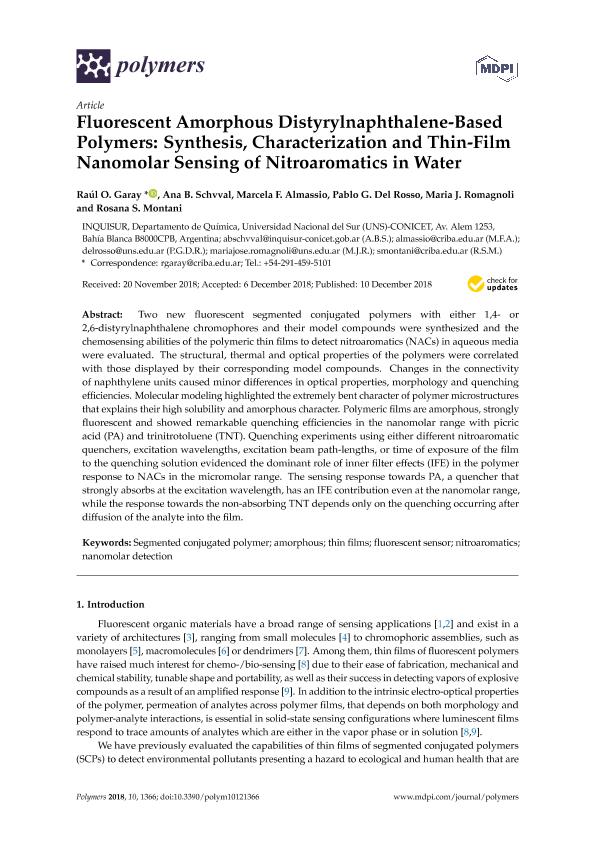Artículo
Fluorescent amorphous distyrylnaphthalene-based polymers: Synthesis, characterization and thin-film nanomolar sensing of nitroaromatics in water
Garay, Raúl Oscar ; Schvval, Ana Belén
; Schvval, Ana Belén ; Almassio, Marcela
; Almassio, Marcela ; del Rosso, Pablo Gabriel
; del Rosso, Pablo Gabriel ; Romagnoli, María; Montani, Rosana
; Romagnoli, María; Montani, Rosana
 ; Schvval, Ana Belén
; Schvval, Ana Belén ; Almassio, Marcela
; Almassio, Marcela ; del Rosso, Pablo Gabriel
; del Rosso, Pablo Gabriel ; Romagnoli, María; Montani, Rosana
; Romagnoli, María; Montani, Rosana
Fecha de publicación:
12/2018
Editorial:
Multidisciplinary Digital Publishing Institute
Revista:
Polymers
ISSN:
2073-4360
Idioma:
Inglés
Tipo de recurso:
Artículo publicado
Clasificación temática:
Resumen
Two new fluorescent segmented conjugated polymers with either 1,4- or 2,6-distyrylnaphthalene chromophores and their model compounds were synthesized and the chemosensing abilities of the polymeric thin films to detect nitroaromatics (NACs) in aqueous media were evaluated. The structural, thermal and optical properties of the polymers were correlated with those displayed by their corresponding model compounds. Changes in the connectivity of naphthylene units caused minor differences in optical properties, morphology and quenching efficiencies. Molecular modeling highlighted the extremely bent character of polymer microstructures that explains their high solubility and amorphous character. Polymeric films are amorphous, strongly fluorescent and showed remarkable quenching efficiencies in the nanomolar range with picric acid (PA) and trinitrotoluene (TNT). Quenching experiments using either different nitroaromatic quenchers, excitation wavelengths, excitation beam path-lengths, or time of exposure of the film to the quenching solution evidenced the dominant role of inner filter effects (IFE) in the polymer response to NACs in the micromolar range. The sensing response towards PA, a quencher that strongly absorbs at the excitation wavelength, has an IFE contribution even at the nanomolar range, while the response towards the non-absorbing TNT depends only on the quenching occurring after diffusion of the analyte into the film.
Archivos asociados
Licencia
Identificadores
Colecciones
Articulos(IFISUR)
Articulos de INSTITUTO DE FISICA DEL SUR
Articulos de INSTITUTO DE FISICA DEL SUR
Articulos(INQUISUR)
Articulos de INST.DE QUIMICA DEL SUR
Articulos de INST.DE QUIMICA DEL SUR
Citación
Garay, Raúl Oscar; Schvval, Ana Belén; Almassio, Marcela; del Rosso, Pablo Gabriel; Romagnoli, María; et al.; Fluorescent amorphous distyrylnaphthalene-based polymers: Synthesis, characterization and thin-film nanomolar sensing of nitroaromatics in water; Multidisciplinary Digital Publishing Institute; Polymers; 10; 12; 12-2018; 13661-136613
Compartir
Altmétricas



